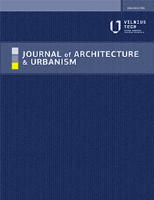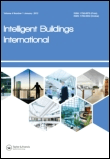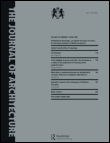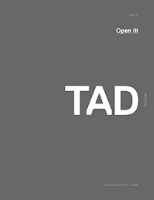
Architect
Scope & Guideline
Cultivating Knowledge in the Evolving Landscape of Architecture
Introduction
Aims and Scopes
- Sustainable Architecture:
Focuses on design practices that promote environmental sustainability, including carbon neutrality, energy efficiency, and the use of eco-friendly materials. - Equity and Inclusion in Design:
Addresses issues of social justice within architecture, emphasizing the importance of equitable access to design and representation of diverse voices in the profession. - Technological Integration:
Examines the role of technology in architecture, including advancements in building information modeling (BIM), digital design tools, and the impact of artificial intelligence. - Community and Urban Design:
Explores how architecture can engage with and enhance communities, focusing on urban resilience, adaptive reuse, and the integration of public spaces. - Architectural Education and Practice:
Discusses the evolving nature of architectural education and professional practice, including mentorship, licensure, and the challenges faced by emerging professionals. - Cultural Narratives in Architecture:
Investigates how architecture reflects and shapes cultural identities, with a focus on historical context and the narrative power of design.
Trending and Emerging
- Carbon Neutrality and Climate Action:
An increasing number of articles focus on strategies for achieving carbon neutrality in building design, reflecting a global urgency to combat climate change and promote sustainable practices. - Adaptive Reuse and Resilience:
There is a notable trend towards adaptive reuse of existing structures, emphasizing resilience in design to meet contemporary needs while respecting historical contexts. - Digital Transformation in Architecture:
Emerging discussions on the impact of digital tools and technologies, including AI and virtual reality, are reshaping architectural practices and education. - Social Justice and Design Justice:
A growing emphasis on design justice highlights the importance of architecture in promoting social equity and inclusive practices, responding to calls for greater representation in the field. - Health and Well-Being in Built Environments:
There is an increasing focus on how architecture influences health and well-being, with explorations of biophilic design and the WELL Building Standard gaining traction.
Declining or Waning
- Traditional Architectural Styles:
There has been a noticeable decrease in discussions centered on traditional architectural styles and historical preservation, as contemporary practices increasingly prioritize innovation and sustainability. - Material Science Innovations:
Discussions on new materials and their scientific properties have declined, possibly overshadowed by broader sustainability conversations and the push for carbon-positive designs. - Commercial Architecture Trends:
The emphasis on commercial architecture and large-scale developments has waned, with more focus shifting towards residential projects and community-oriented architecture. - Passive Design Strategies:
While once a staple in architectural discourse, the specific exploration of passive design strategies has diminished, as more integrative approaches to sustainability have taken precedence. - Regulatory and Compliance Issues:
Topics surrounding regulatory compliance and building codes appear less frequently, possibly due to a shift towards more practical discussions on innovative design solutions.
Similar Journals

Journal of Architecture and Urbanism
Innovating Architecture for Sustainable CitiesThe Journal of Architecture and Urbanism, published by VILNIUS GEDIMINAS TECH UNIV, stands as a pivotal resource for scholars and practitioners in the fields of architecture and urban studies. Since its inception in 2012, the journal has committed to advancing research and discourse on the design, planning, and functionality of urban environments, reflecting a dedicated focus on contemporary challenges in architecture and urbanism. With an impressive open access model implemented since 2018, it ensures that innovative research is accessible to a global audience, fostering collaboration and knowledge exchange. The journal boasts a commendable reputation, categorized in the Q2 quartile for Architecture and Q3 in both Geography, Planning and Development and Urban Studies as of 2023, while maintaining respectable Scopus rankings. Addressing key themes from sustainable design to socio-economic impacts on urban spaces, the journal aims to inspire new models and solutions that meet the evolving needs of growing urban populations. This is a must-read for anyone engaged in the intersection of architecture and urban development.

Landscape Architecture Frontiers
Cultivating knowledge in landscape architecture.Landscape Architecture Frontiers, an esteemed journal published by Higher Education Press, serves as a pivotal platform for the dissemination of innovative research and critical thinking within the field of landscape architecture. Recognized for its commitment to advancing global discourse on sustainable design, environmental stewardship, and urban ecology, the journal's content is crucial for researchers, professionals, and students alike who are dedicated to shaping the future of landscape architecture. With a diverse range of topics covered, including landscape planning, restoration ecology, and cultural landscapes, this journal aims to foster interdisciplinary collaboration and promote best practices in the discipline. Although specific metrics like the impact factor and HIndex are not provided, the journal's reputation within the academic community underlines its significance in contributing to ongoing education and professional development in landscape architecture. For those interested in open access options, Landscape Architecture Frontiers encourages engagement and wider readership through its research, making it an essential resource for anyone passionate about the transformative power of landscapes and public spaces.

Intelligent Buildings International
Pioneering the Future of Smart Building TechnologiesIntelligent Buildings International, published by Taylor & Francis Ltd, is a premier journal dedicated to advancing knowledge in the interdisciplinary domains of building construction, civil engineering, computer science applications, and planning. Since its inception in 2009, this journal has become a vital resource for researchers, professionals, and students, offering a platform for high-quality scholarly articles that explore innovative strategies and technologies in intelligent building design and efficiencies. With its significant impact factor reflected in its Q2 and Q3 quartile rankings across various related fields, and strong Scopus rankings placing it among the top journals in Geography, Building, and Civil Engineering, Intelligent Buildings International stands out for its commitment to fostering research that enhances the sustainability and functionality of contemporary architectural practices. Readers can access a wealth of articles that illuminate the complexities of smart building technologies and their implications for future construction practices, making it an essential addition to any academic library.

Journal of Architecture and Planning -King Saud University
Transforming Spaces, Shaping Futures.Journal of Architecture and Planning, published by King Saud University Press, serves as a critical platform for scholarly dialogue and innovation within the field of architecture and urban planning. This peer-reviewed journal, bearing the ISSN 1018-3604, aims to disseminate high-quality research that addresses contemporary challenges in architectural design, environmental sustainability, and urban development. Situated in Riyadh, Saudi Arabia, this journal not only highlights regional architectural practices but also fosters global discussions, making it an essential resource for researchers, professionals, and students alike. Although currently not open access, the journal is dedicated to providing extensive coverage of the latest findings and theoretical advancements in architecture and planning, paving the way for impactful contributions that can transform communities and enhance the built environment.

ARCHITECTURAL RECORD
Advancing Knowledge in Architecture and DesignARCHITECTURAL RECORD, published by McGraw Hill Inc, stands as a vital resource in the field of architecture and design, offering insightful perspectives and critical analyses that cater to architects, designers, and academia alike. With an ISSN of 0003-858X, this prestigious journal has been a cornerstone for the architectural community, providing a blend of contemporary practices and theoretical frameworks since its inception. Although it is not currently available through Open Access, its rich content contributes to the ongoing dialogue in both the Visual Arts and Performing Arts, as well as Engineering and Architecture disciplines. The journal's historical impact can be seen through its wide readership and influence in shaping architectural discourse, making it a highly regarded publication for professionals and students in the field. As a beacon of innovative practices, ARCHITECTURAL RECORD continues to inspire and educate, even despite its coverage discontinuation in Scopus since 2018.

Techne-Journal of Technology for Architecture and Environment
Exploring the Nexus of Technology and EnvironmentTechne - Journal of Technology for Architecture and Environment, published by FIRENZE UNIV PRESS, is an important academic platform that bridges the gap between technology and architecture while addressing the evolving environmental challenges of our time. Established in 2015, this journal provides a forum for innovative research and discussions that critically examine the intersections of architecture, urban studies, and construction engineering. With an impact factor indicative of growing recognition in its field, Techne encompasses a broad spectrum of studies, marking its presence in the Q3 and Q4 quartiles across various categories, including Architecture, Building and Construction, Education, and Health (Social Science). The journal is indexed in Scopus with varying ranks, showcasing its increasing relevance and influence among contemporary literature. Although it operates under a non-open access model, the journal ensures that its scholarly contributions are accessible through institutional connections, making it a vital resource for researchers, professionals, and students seeking to advance their knowledge on the integration of technology in shaping sustainable architectural practices.

Journal of Architecture
Fostering interdisciplinary dialogue for a sustainable built environment.Journal of Architecture, published by ROUTLEDGE JOURNALS, TAYLOR & FRANCIS LTD, stands as a pivotal platform for scholarly discourse in the ever-evolving field of architecture. Established in 1996, this esteemed journal boasts an impressive impact factor, categorized as Q2 in Architecture and Q1 in Visual Arts and Performing Arts, reflecting its significant contribution to both disciplines. With a robust Scopus ranking positioning it in the 85th percentile among Visual Arts and Performing Arts and the 57th percentile within Engineering Architecture, the journal serves as an essential resource for researchers, professionals, and students alike. The Journal of Architecture features innovative research and thoughtful analysis that shape contemporary architectural practices and theories, encouraging interdisciplinary dialogue. Engaging with this journal allows readers to stay abreast of critical advancements and emerging trends, fostering a deeper understanding of architecture's role in societal transformation.

Technology-Architecture + Design
Elevating the Discourse on Smart UrbanismTechnology-Architecture + Design is a pioneering academic journal published by Taylor & Francis Ltd, dedicated to exploring the intersection of technology within architectural and design practices. With an impactful presence in the field since its inception in 2017, the journal has quickly ascended in academic rankings, achieving a Q2 categorization in Architecture and a notable Q1 ranking in Visual Arts and Performing Arts, underscoring its significance in these dynamic areas of study. The journal aims to provide an open platform for innovative research that addresses contemporary challenges in architecture and urban planning, utilizing technological advancements as a central theme. As a vital resource for scholars, practitioners, and students alike, Technology-Architecture + Design publishes high-quality, peer-reviewed articles that contribute to the discourse surrounding sustainable design, digital fabrication, and smart urbanism, making it an essential read for those passionate about the future of built environments.

Frontiers of Architectural Research
Pioneering Solutions for Contemporary Architectural ChallengesFrontiers of Architectural Research, published by KEAI PUBLISHING LTD, stands at the forefront of interdisciplinary scholarship, addressing contemporary challenges in the fields of architecture, urban studies, building and construction, and archaeology. Since its establishment in 2012, this open-access journal has rapidly gained recognition, achieving prestigious rankings in the 2023 category quartiles, including Q1 placements in both Architecture and Archaeology. With an impressive Scopus rank of #5 out of 354 in Archaeology and #10 out of 189 in Engineering - Architecture, it demonstrates its significant influence and contribution to advancing architectural research. Frontiers of Architectural Research embraces a broad scope that fosters innovative discourse and practical solutions, catering to a diverse audience of researchers, professionals, and students keen on exploring the intersection of culture, environment, and technology. By ensuring immediate access to research findings, the journal not only enhances the visibility of scholarly work but also encourages collaborative dialogues that shape the future of architectural practice.

Japan Architectural Review
Exploring the intersection of architecture and environmental engineering.Japan Architectural Review is a premier open-access journal published by WILEY, dedicated to advancing the fields of architecture, environmental engineering, and modeling and simulation. Since its inception, this journal has emerged as a critical platform for disseminating innovative research, offering insights into the latest trends and challenges facing the built environment and sustainability practices. With an impact factor reflecting its growing influence, especially in the Q2 category of Architecture and notable rankings in environmental engineering and modeling disciplines, it serves as an essential resource for researchers, professionals, and students alike. The journal's commitment to open access since 2018 has further enhanced its reach, making high-quality research accessible to a global audience. Spanning an important timeline from 2019 to 2024, the Japan Architectural Review facilitates a collaborative discourse among scholars, encouraging innovative solutions to contemporary architectural challenges.